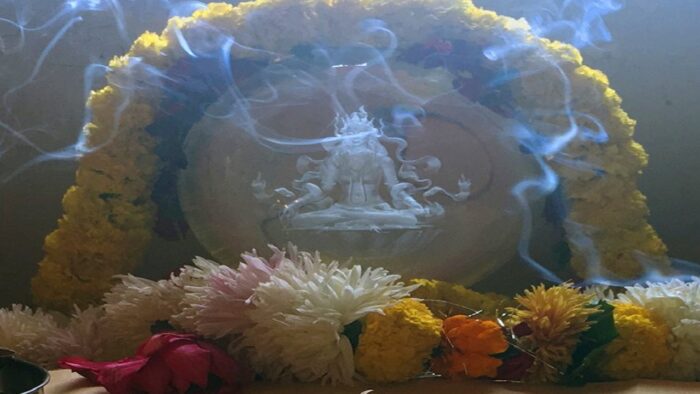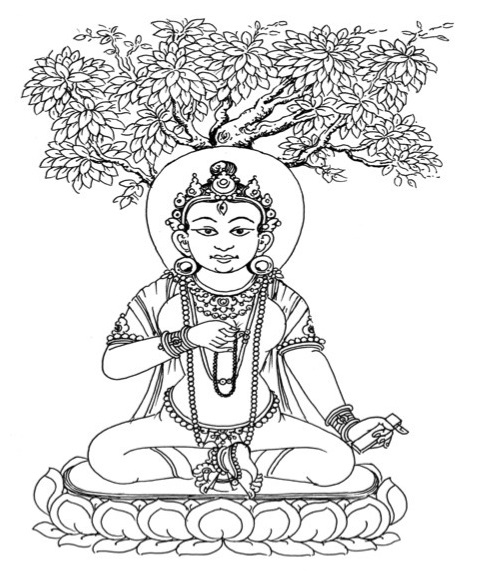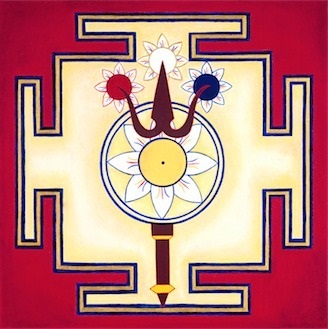The Goddess Parā[1] is the tutelary deity of the non-dualistic Śaiva tradition referred to as the Trika. Trika Śaivism flourished in Kashmir and India from the 9th to 13th century and a significant contribution to its development were the works of the great philosopher and exegete Rajānaka Abhinavagupta (c. 975-1025 CE). Though the tradition has been through a long process of attrition since the 13th century, and was almost lost, it was revealed again by one of the last Kashmiri teachers of the Trika, Swami Lakshmanjoo, who transmitted the tradition to a few Westerners as well as Indians in the decades before his death in 1991. The tradition is now in a process of revival not only in Kashmir and India but worldwide, a phenomenon which has recently been explored in depth by Douglas Osto in his book An Indian Tantric Tradition and its Global Revival.[2] My profound conviction, and that of many others, is that this tradition is not only of historical and philosophical interest, but contains saving knowledge that is vital to humanity today. As a contribution to the contemporary evolution of the Trika, in 2016 I was inspired to create a sculpture the Goddess Parā. This essay will explore the significance of the Goddess Parā within the context of the Trika and the creation of this artwork.
(Figure 1: Credit: Internetarchive – Sri Swami LakshmanJoo, Kashmiri Śaiva Acharya)
Trika Śaivism is a study of Consciousness, from both a theoretical and an experiential perspective. It is practical in its outlook and methods, which are aimed at self-realization. The philosophy of this tradition is centred around an understanding of Consciousness as the ground-of-being, unbounded and infinite. The teachings and practices of Trika Śaivism recognize that by aligning our individuality with the autonomous and free nature of Consciousness we experience more creativity, higher functioning, and an ever-deepening connection to the truth, sacredness, and beauty of embodied existence.
While this tradition holds that Consciousness is one, it also explains how its characteristics and functions are many, and an entire pantheon of deity forms exists that embody these various aspects. These deity forms are described in writing in texts of the tradition but most of them have never been represented in sculptural form, making it all the more pertinent to bring them to light for those seeking to authentically engage with the tradition in the present era. The iconographic elements of the deity forms are both indicators and activators, indicating via visual codes the aspect of Consciousness being expressed by the deity and activating that same experience within the individual. Though these deity forms may at first resemble the iconography of certain religious systems, an engagement with Trika Śaivism is not a matter of practicing religion in the conventional sense but is rather akin to a universal philosophical theory with profound and pragmatic applications. In the words of Swami Lakshmanjoo:
Trika Philosophy is meant for any human being, without the restriction of cast, creed, or color. Its purpose is to enable you to rise from individuality to universality.[3]
Abhinavagupta, in his magnum opus the Tantrāloka, speaks about the role of ritual and deity forms for a practitioner. Though the primary focus of the Trika according to Abhinavagupta is an inner meditative practice, he does not suggest abandoning deity forms altogether but rather he explains how one must aspire to see these forms, as nothing less than one’s own essential nature, collapsing any conception of the difference between oneself and the deity:
In this mirror-like consciousness, he should contemplate the images of the deities as reflections of himself as the reflected.[4]
(Figure 2: Credit: Wikipedia – Acharya Abhinavagupta)
In creating the sculpture of Goddess Parā, I have attempted to honour the point of view of Abhinavagupta. Though Parā is a deity form that would have been traditionally used for an internal visualization practice, the fact of her external materialization as the sculpture is not intended to illicit a separation between the observer and the work of art, but rather a unification of the viewer with what is being viewed.
There are several different visualization descriptions of the Goddess Parā within the Trika textual corpus. The one followed as the basis for this representation is from the Siddhayogeśvarīmata, translated by Mark S. G. Dyczkowski
One should visualize Parā with her own form, sitting on a lotus in the air, with the book of all knowledge in her left hand, O Beautiful One, and holding a beautiful heavenly rosary of crystal in her right hand. One is to visualize a garland on her neck, a garland of heavenly beauty, made up with beads which are round like the buds of the Kadamba tree and which shine forth like fire. This garland reaches down to her feet and is as spotless as crystal all over.[5]
This description is rendered anthropomorphically in my sculpture using the aesthetic and iconographic vocabulary of traditional Indo-Tibetan sacred art, and each element of the form expresses an aspect of the Goddess Parā as she is described in the texts of the Trika tradition. Furthermore, the material of the sculpture, the shape of the sculpture, and the process by which it is sculpted, have also been considered as ways of indicating and activating qualities associated with this Goddess.
In the Trika tradition, the Goddess Parā is understood as the Goddess of creation, the primordial will of Consciousness in its unmanifest state to become manifest. In terms of the process of manifestation, she is the very first movement of the immanent that emerges in union with the transcendent. This subtle state she embodies is expressed in the description from the Siddhayogeśvarīmata where she is described as having a white body of the crystal. Sculpting her in the crystal was therefore a fitting medium for this Goddess, who in her expressive capacity is the activating force that disperses the one light of Consciousness into the variegated array of forms in the manifest world, just as crystal disperses white light into the full spectrum of colors.
The form of the Goddess is embedded within the solid crystal sphere by a method of three-dimensional laser etching. This is done by sending millions of beams of light to the interior of the crystal. At the focal point of each beam of light a tiny occlusion is etched into the crystal making up the appearance the entire form, which then shines visibly when light from the outside passes through. This process is used because it approximates the manner in which she is described in the Trika texts, luminous white like sunshine on snow.[6] The fine quality of the etching is a way of capturing the subtlety of her effulgent nature, demonstrating in material form that she is at the very edge of what can be seen, described, and depicted. This technique enables a vision of the Goddess appearing to float weightless within the crystal, expressing immanence in union with transcendence emerging subtly from infinite spaciousness as joyous creative impulse. It offers an experience of the Goddess Parā as the highest principle of reality, completely out of the mind’s reach, yet at the same time experienced at every moment as one’s own self-awareness, present in all things.
(Figure 3: Credit: anuttaratrikakula – Sri Mata Parā From Siddhayogeshwaramitha)
The spherical shape of the sculpture is also significant in terms of Tantric iconography because it is a pure geometric form, without corners or edges. The sphere has no face to stand on, so it is filled with latent dynamism, with infinite possibility and potential for movement in any direction. This shape therefore represents and elicits the unbounded unity of universal consciousness that is the true nature of the individual.
These elements of the sculpture are ways of expressing the qualities of the Goddess Parā and as mentioned previously they are also a means of activating those qualities within the viewer. There are three qualities in particular which are associated with the Goddess Parā that are relevant to discuss in this context – icchā, pratibhā, and camatkāra.
The word icchā in common language can mean desire, however in this context it is not desire for an object or an experience we have knowledge about already but rather the unconditional impulse of desire. In the Trika icchā is defined as a precognitive creative urge toward self-expression. It is the impulse behind the manifestation of the universe and behind all artistic expression that is done for its own sake. It is the initial stirring of the unconditioned will of consciousness to manifest, the primordial motive force of consciousness without which nothing would arise, and everything would remain static and formless. Icchā is the desire of the Goddess Parā to experience herself for no other reason than to delight in the creative act itself. At the level of the individual, this subtlest of movements surges up from the core of one’s being freely and autonomously. It is not the product of logical argument, rational thought or persuasion. When an artist is seized by the unconditional urge to create, by an impulse that does not require justification nor explanation, this is a direct experience of the cosmic will – icchā – of the Goddess Parā operating through the embodied being. If this impulse is allowed to flow unimpeded of its own accord, it will inevitably be accompanied by the guidance of intuitive insight – pratibhā.
(Figure 4: Credit: Wikiwand – The Triśūlābija Maṇḍalam symbol and yantra of Parama Shiva, representing the triadic energies of the Supreme Goddess Para, Para-apara and Apara Shakti)
Pratibhā is a technical term in the field of aesthetics and the philosophy of language, however in the Tantrāloka Abhinavagupta uses this word not only to describe the qualities of the Goddess Parā, but as an actual name for her, Goddess Pratibhā (Pratibhādevī), which qualifies and signifies the aspect of ultimate reality that she represents.[7] A single equivalent word for pratibhā does not exist in English but it could be translated as “creative inspiration”, “intuitive insight”, and “divine knowledge”. We could consider Pratibhā as the sudden flash of insight that compels the poet to put pen to paper, or the vision like lightning from beyond that seizes the painter. It is also the underlying impulse that inspires a bird to sing, and the innate intelligence of the newly born kitten that moves it towards the mother’s teat. It is not an individual human skill but rather the underlying intuitive intelligence force of consciousness. This macrocosmic characteristic of the Goddess Parā moving through microcosmic channel of the embodied being is what moves all great artists, constituting the very essence of their creativity. It is an inherent quality of reality which is beyond any individual’s ability to produce it or own it. It can however be easily confused by the artist as something self-generated, if the artist’s mind attempts to take possession of it. On the other hand, the artist who honours the originating impulse of creativity (icchā) and surrenders to the unfolding of intuitive insight (pratibhā), will inevitably create art that touches the core of being and expresses that which is eternal.
The term camatkāra means wonder or aesthetic rapture. It is the ecstatic experience of a fully expanded state of awareness that sums up both the activity of consciousness and the contemplation which is the result of its action. According to André Padoux:
Parāvāc is characterized by camatkāra, wonder, thrill of joy, wonderment, and ecstatic rapture, experienced by consciousness at its self-revelation and its self-awareness, or when contemplating the manifestation that it holds within itself.[8]
One experiences the Goddess Parā as camatkāra when consciousness becomes suffused with such beauty that the experience of time fades away. As one is swept up in aesthetic delight the fundamental nature of consciousness unafflicted by thought constructs is revealed, and the sense of a separate self dissolves into an experience of one eternal being. This understanding is at the core of Abhinavagupta’s aesthetic theory, elucidated here by Raniero Gnoli:
During the aesthetic experience, the consciousness of the spectator is free from all practical desires. The spectacle is no longer felt in connexion with the empirical “I” of the spectator nor in connexion with any other individual; it has the power of abolishing the limited personality of the spectator, who regains, momentarily, his immaculate being not yet overshadowed by māyā.[9]
According to Abhinavagupta, the purpose of art is to exercise our capacity to perceive the fundamental reality of all things.[10] An artwork gives access to the reality of pure aesthetic continuity which otherwise would remain unnoticed amidst the distractions of everyday life. Art can take us for a moment outside of time and space because we are looking at something captured by the artist in a timeless moment of unity with the ever-present creative force of consciousness. In other words, the contemplation of art is participating in the act of creating a work of art, and the act of creating a work of art is participating in Parā’s act of creating the whole world. The teachings of Trika Śaivism articulate how through specific practices and identification with the qualities embodied by the Goddess Parā, camatkāra is realized as the fundamental nature of consciousness, no longer limited to the experience of a specific object or event, but an inherent quality of being, making the whole of life a work of art. It is this Goddess Parā, who in sculpted form becomes a mirror for the beauty and power we have inherent within, to be experienced and ultimately revealed.
[1]Edited by MariyaKaragyozovaand Stephanie Corigliano
[2]Douglas Osto, An Indian Tantric Tradition and its Global Revival (New York, Routledge, 2020) p1
[3] Swami Lakshmanjoo, Universal Shaiva Fellowship Homepage<www.universalshaivafellowship.com> [accessed 30 January 2019]
[4] Alexis Sanderson, The Visualization of the Deities of the Trika (Paris, Editions du CNRS, 1990) p73
[5] Mark S. G Dyczkowski, ManthanabhairavatantramIntroduction Vol. 2. (Varanasi, Indira Gandhi National Centre 2009) p131
[6] Alexis Sanderson, The Visualization of the Deities of the Trika(Paris, Editions du CNRS, 1990) p54
[7] Ernst Fürlinger,‘The Doctrine of Pratibhā in Selected Texts of Abhinavagupta’ in Tantrapuṣpāñjali- Tantric Traditions and Philosophy of Kashmir, ed. by Bettina Bäumer, and Hamsa Stainton,(New Delhi, Indira Gandhi National Centre for Arts & Aryan Books International, 2018) pp. 303-324 (p314)
[8]André Padoux, Vāc (New York, SUNY Press, 1990) p174
[9]Raniero Gnoli,The Aesthetic Experience According to Abhinavagupta, 2ndedn (Varanasi, Chowkhamba Sanskrit Series, 1986) pXXI
[10]Mark Dyczkowski, Art, Perception and the Sacred: An Indian Perspective (Public Lecture), National Gallery of Victoria Australia, 2014-09-14
Feature Image Credit : christiandevietri.com
Watch video presentation of the above paper here:
Disclaimer: The opinions expressed in this article belong to the author. Indic Today is neither responsible nor liable for the accuracy, completeness, suitability, or validity of any information in the article.












